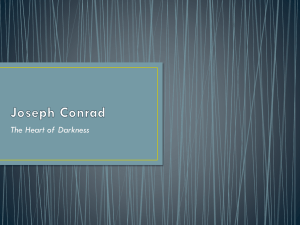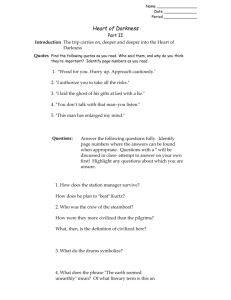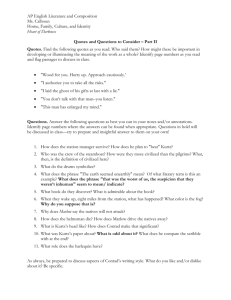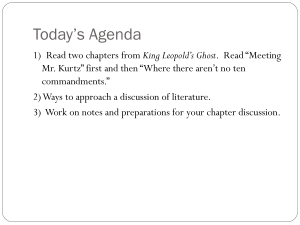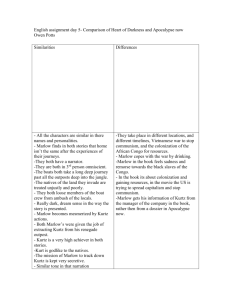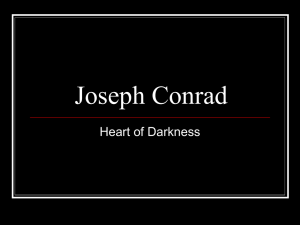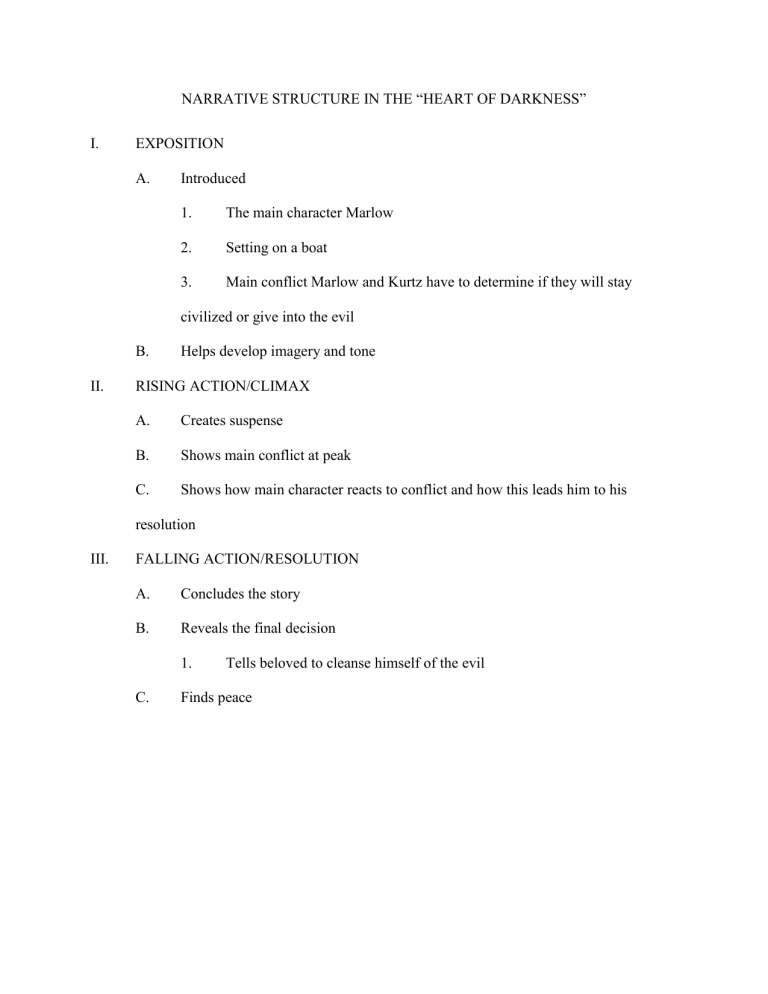
NARRATIVE STRUCTURE IN THE “HEART OF DARKNESS” I. EXPOSITION A. Introduced 1. The main character Marlow 2. Setting on a boat 3. Main conflict Marlow and Kurtz have to determine if they will stay civilized or give into the evil B. II. Helps develop imagery and tone RISING ACTION/CLIMAX A. Creates suspense B. Shows main conflict at peak C. Shows how main character reacts to conflict and how this leads him to his resolution III. FALLING ACTION/RESOLUTION A. Concludes the story B. Reveals the final decision 1. C. Tells beloved to cleanse himself of the evil Finds peace The “Heart of Darkness” by Joseph Conrad is a story about a sailor who comes across evil and darkness and his journey to overcome it. To create this story Conrad had to use five steps which are called narrative structure. Narrative structures are split into five parts: exposition, rising action, climax, falling action, and resolution. Authors use these five parts to create stories that are interesting and smooth to read. The “Heart of Darkness” by Joseph Conrad utilizes all five of these parts to create a dark and compelling story. Exposition is the introduction of the story or writing. It is where the author introduces the readers to the characters, establishes a setting, and presents the primary conflict of the story. In “Heart of Darkness,” Conrad creates a clear exposition. At the beginning of the story, Conrad introduces the readers to the person who will be the main character of the story, Marlow. The readers are given a description of the main character and a peek into his personality. “He had sunken cheeks, a yellow complexion, a straight back, an ascetic aspect, and, with his arms dropped, the palms of hands outwards, resembled an idol.” (3) Giving an in-depth description of the main character allows the readers to know who they are dealing with. Whether the character is pretty or ugly and whether the person is kind or evil. The setting of the story is placed on a boat traveling the Thames River, though the setting changes throughout the story Congo is the main setting. The primary conflict in the story is that Marlow and Kurtz are put to the test as to whether they will abandon their European values and morals and submit to savagery or stay “civilized.” The exposition in the story helps set up a certain level of imagery and mood. The readers can imagine the main character and where the story takes place while also realizing that because of the main conflict described the story is dark and sad. Rising action and climax are the most important and complicated parts of a story. The rising action is the part of a story that helps develop the main conflict and the characters through events that build interest and suspense. The climax is the turning point or most exciting part of a story because it is where the conflict reaches its peak. In “Heart of Darkness, the rising action is very important because it gives a lot of context as to the reason behind the climax. The rising action in the story is that Marlow happens to overhear people on the boat talking about Europeans who are having mental breakdowns and becoming savage and wonder whether he and Kurtz should abandon their morals and give into savagery. (22) The events that happen rising action then lead into the climax. During the climax, Marlow learns that Kurtz has completely abandoned European norms and morals. Rising action and climax push the story forward to show the issues and internal conflict the characters face. They also make way to help the reader understand the character's final decision. In “Heart of Darkness” after readers have been through the exposition, rising action, and climax, they then experience the falling action and resolution. Falling action and Resolution are concluding parts of a story. Falling action are the parts of the story that get a reader ready for the end of a story. Resolution is the conclusion of a story where the conflicts are resolved. The falling action in the story is when Marlow and Kurtz are on their way back home and Kurtz dies which causes Marlow to become obsessed with him. Marlow states “However, as you see, I did not go to join Kurtz there and then. […] I remained to dream the nightmare out to the end, and to show my loyalty to Kurtz once more.” (117) These lines start to show the resolution of Marlow’s journey and conviction. This leads to the actual resolution where Marlow reveals Kurtz’s hideous deeds to his beloved. In the resolution, Marlow reveals the consuming evil and madness that Kurtz faced. The falling action and resolution in the story show that lessons were learned and that Marlow had let go and “cleansed” himself of the consuming evil. The “Heart of Darkness” is a good example of a story that utilizes narrative structure. The exposition introduced Marlow sailing a boat in the Thames River telling a story about himself and Kurtz facing evil in the forest and whether they should give into it or hold out. The rising action and climax pushed the story forward by showcasing events that build more suspense towards the main conflict and how it ended with Kurtz succumbing to the evil. The falling action and resolution conclude the story by showing that Kurtz died, and Marlow had made his decision to honor Kurtz’s legacy and went to reveal what happened to Kurtz’s beloved “cleansing” himself of the evil. These steps develop the story by clearly revealing what was happening and how they flowed easily into each other. Works Cited Page Conrad, Joseph. “Heart of Darkness.” Planet EBook |, 8 Mar. 2018, https://www.planetebook.com/heart-of-darkness/.
